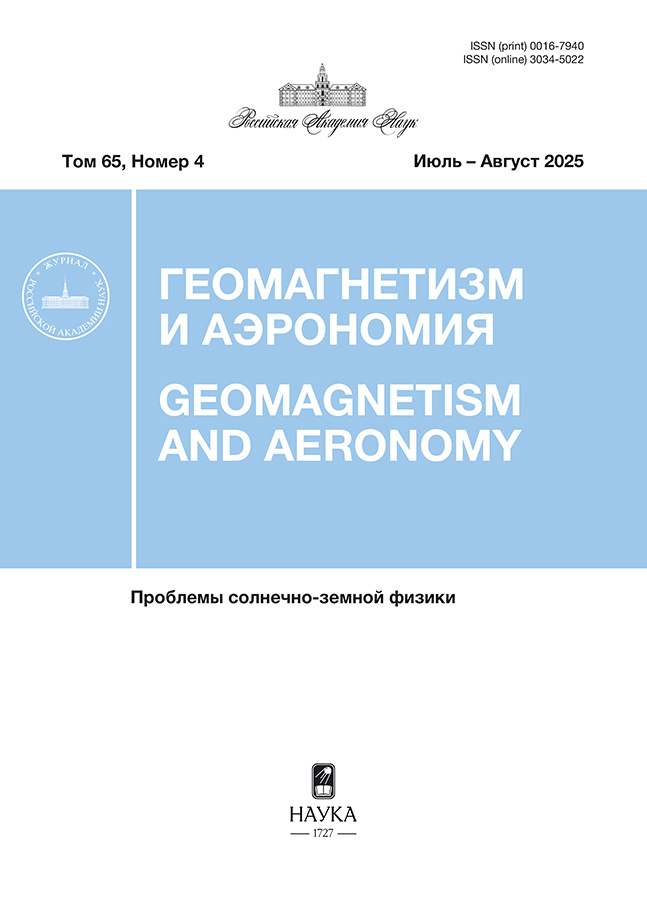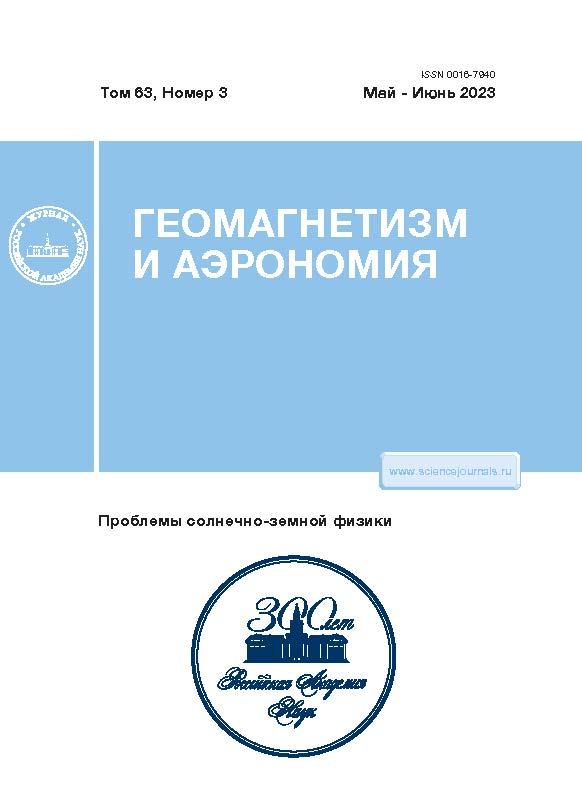Disturbances in the Magnetosphere and Ionosphere during Spotless Sun
- Authors: Gulyaeva T.L.1
-
Affiliations:
- Institute of Terrestrial Magnetism, Ionosphere and Radio Wave Propagation (IZMIRAN)
- Issue: Vol 63, No 3 (2023)
- Pages: 340-348
- Section: Articles
- URL: https://ruspoj.com/0016-7940/article/view/651014
- DOI: https://doi.org/10.31857/S0016794022600582
- EDN: https://elibrary.ru/UIRLXK
- ID: 651014
Cite item
Abstract
Analysis of geomagnetic and ionospheric activity is performed for 541 disturbed days during spotless
Sun (Kp > 3.0) from 1995 to 2021. Variations of the global ionospheric indices WU (positive disturbances
of total electron content), WL (negative disturbances), their range WE and the planetary index Wp are analyzed.
The source W-index characterizes a measure of deviation of the instant total electron content from the
quiet median varying from −4 to +4 with a step 1, and the global indices WU, WL, WE, Wp are derived from
the global maps GIM-TEC of Jet Propulsion Laboratory, JPL. Investigation of the seasonal dependence has
revealed two levels of the ionosphere disturbances: the low disturbance of the ionosphere during 1996‒1998
and 2018‒2021 and the high disturbance during 2004‒2010 and 2016‒2017. The seasonal ionosphere variations
are different for two sets of the data. The seasonal variations of the solar wind velocity Vsw near the Earth
orbit are first identified for the 1st data set displaying the peaks at the equinoxes similar to variations of the
Kp-index. The 2nd set of the high disturbance of the ionosphere refers to the epoch of transition from the high
solar activity SA to low SA characterized by the total restructuring of the physical conditions on the Sun
About the authors
T. L. Gulyaeva
Institute of Terrestrial Magnetism, Ionosphere and Radio Wave Propagation (IZMIRAN)
Author for correspondence.
Email: gulyaeva@izmiran.ru
Troitsk, Moscow, 142191 Russia
References
- − Афраймович Э.Л., Астафьева Э.И., Живетьев И.В. Солнечная активность и глобальное электронное содержание // ДАН. Т. 409. № 3. С. 399‒402. 2006.
- − Гуляев Р.А. Действительно ли солнечная корона отсутствовала в период Маундеровского минимума? // Астрономия-2018. Т. 2: Солнечно-земная физика – современное состояние и перспективы. М.: ГАИШ. С. 55‒58. 2018. https://doi.org/10.31361/eaas.2018-2.013
- − Гуляев Р.А., Гуляева Т.Л. Возрастание мощности центральной корональной дыры к минимуму солнечной активности: реакция ионосферы // Астрономия-2018. Т. 2: Солнечно-земная физика – современное состояние и перспективы. М.: ГАИШ. С. 59‒62. 2018. https://doi.org/10.31361/eaas.2018-2.014
- − Гуляева Т.Л., Хараламбус Х. Трехчасовые индексы ионосферной активности // Геомагнетизм и аэрономия. Т. 61. № 6. С. 741‒750. 2021. https://doi.org/10.31857/S0016794021060079
- − Ишков В.Н. Итоги и уроки 24 цикла – первого цикла второй эпохи пониженной солнечной активности // Астрон. журн. Т. 99. № 1. С. 54–69. 2022. https://doi.org/10.31857/S0004629922020050
- − Котонаева Н.Г., Коломина М.В., Михайлов В.В., Цыбуля К.Г., Филиппов М.Ю. Эффективность коррекции ионосферных моделей по данным одного ионозонда вертикального радиозондирования в период низкой солнечной активности // Геомагнетизм и аэрономия. Т. 61. № 1. С. 85‒93. 2021. https://doi.org/10.31857/S0016794021010089
- − Тимченко А.В., Бессараб Ф.С., Клименко М.В., Радиевский А.В., Клименко В.В. Корреляционный анализ глобальных ионосферных карт полного электронного содержания в марте 2015 г. // Геомагнетизм и аэрономия. Т. 62. № 3. С. 345‒354. 2022. https://doi.org/10.31857/S0016794022030191
- − Chen Y., Liu L., Wan W. Does the F10.7 index correctly describe solar EUV flux during the deep solar minimum of 2007–2009? // J. Geophys. Res. ‒ Space. V. 116. A04304. 2011. https://doi.org/10.1029/2010JA016301
- − Clette F., Svalgaard L., Vaquero J.M., Cliver E.W. Revisiting the sunspot number: a 400-year perspective on the solar cycle // Space Sci. Rev. V. 186. № 1–4. P. 35–103. 2014. https://doi.org/10.1007/s11214-014-0074-2
- − Goncharenko L.P., Tamburri C.A., Tobiska W.K., Schonfeld S.J., Chamberlin P.C., Woods T.N., Didkovsky L., Coster A.J., Zhang S.-R. A new model for ionospheric total electron content: The impact of solar flux proxies and indices // J. Geophys. Res. ‒ Space. V. 126. № 2. e2020JA028466. 2021. https://doi.org/10.1029/2020JA028466
- − Gulyaeva T.L., Stanislawska I. Derivation of a planetary ionospheric storm index // Ann.-Geophysicae. V. 26. № 9. P. 2645‒2648. 2008. https://doi.org/10.5194/angeo-26-2645-2008
- − Gulyaeva T.L., Arikan F., Stanislawska I. Probability of occurrence of planetary ionosphere storms associated with the magnetosphere disturbance storm time events // Adv. Radio Sci. V. 12. P. 261‒266. 2014. https://doi.org/10.5194/ars-12-261-2014
- − Gulyaeva T.L., Arikan F. Statistical discrimination of global post-seismic ionosphere effects under geomagnetic quiet and storm conditions // Geomat. Nat. Haz. Risk. V. 8. № 2. P. 509‒524. 2017. https://doi.org/10.1080/19475705.2016.1246483
- − Gulyaeva T.L., Gulyaev R.A. Coherent changes of solar and ionospheric activity during long-lived coronal mega-hole from Carrington rotation CR2165 to CR2188 // J. Atmos. Solar-Terr. Phys. V. 179. P. 165‒173. 2018. https://doi.org/10.1016/j.jastp.2018.07.007
- − Gulyaeva T.L., Arikan F., Sezen U., Poustovalova L.V. Eight proxy indices of solar activity for the International Reference Ionosphere and Plasmasphere model // J. Atmos. Solar-Terr. Phys. V. 172. P. 122‒128. 2018. https://doi.org/10.1016/j.jastp.2018.03.025
- − Gulyaeva T.L., Haralambous H., Stanislawska I. Persistent perturbations of ionosphere at diminution of solar and geomagnetic activity during 21–24 solar cycles // J. Atmos. Solar-Terr. Phys. V. 221. Art. № 105706. 2021. https://doi.org/10.1016/j.jastp.2021.105706
- − Gulyaeva T.L., Stanislawska I., Lukianova R. Arctic−Antarctic asymmetry of the ionospheric weather // Adv. Space Res. 2022. https://doi.org/10.1016/j.asr.2022.05.008
- − Hathaway D.H. The Solar Cycle // Living Rev. Sol. Phys. V. 12. № 1. Art № 4. 2015. https://doi.org/10.1007/lrsp-2015-4
- − Hernndez–Pajares M., Juan J.M., Sanz J. et al. The IGS VTEC maps: A reliable source of ionospheric information since 1998 // J. Geodesy. V. 83. № 3–4. P. 263–275. 2009. https://doi.org/10.1007/s00190-008-0266-1
- − Laštovička J. The best solar activity proxy for long-term ionospheric investigations // Adv. Space Res. V. 68. № 6. P. 2354‒2360. 2021. https://doi.org/10.1016/j.asr.2021.06.032
- − Lean J.L. Short term, direct indices of solar variability // Space Sci. Rev. V. 94. № 1‒2. P. 39‒51. 2000. https://doi.org/10.1023/A:1026726029831
- − Marques de Souza Franco A., Hajra R., Echer E., Bolzan M.J.A. Seasonal features of geomagnetic activity: a study on the solar activity dependence // Ann. Geophysicae. V. 39. № 5. P. 929–943. 2021. https://doi.org/10.5194/angeo-39-929-2021
- − Matzka J., Stolle C., Yamazaki Y., Bronkalla O., Morschhauser A. The geomagnetic Kp index and derived indices of geomagnetic activity // Space Weather. V. 19. № 5. e2020SW002641. 2021. https://doi.org/10.1029/2020SW002641
- − Nandy D., Muñoz–Jaramillo A., Martens P.C.H. The unusual minimum of sunspot cycle 23 caused by meridional plasma flow variations // Nature. V. 471. P. 80–82. 2011 https://doi.org/10.1038/nature09786
- − Nava B., Rodríguez-Zuluaga J., Alazo-Cuartas K., Kashcheyev A., Migoya-Orué Y., Radicella S.M., Amory-Mazaudier C., Fleury R. Middle- and low-latitude ionosphere response to 2015 St. Patrick’s Day geomagnetic storm // J. Geophys. Res. ‒ Space. V. 121. № 4. P. 3421–3438. 2016. https://doi.org/10.1002/2015JA022299
- – Schaer S., Gurtner W., Feltens J. IONEX: The IONosphere Map Exchange Format: Version 1.1. // Darmstadt, Germany: ESA/ESOC. 2015. ftp.aiub.unibe.ch/ionex/draft/ ionex11.pdf
- − Shue J.-H., Newell P.T., Liou K., Meng C.-I. Solar wind density and velocity control of auroral brightness under normal interplanetary magnetic field conditions // J. Geophys. Res. ‒ Space. V. 107. № A12. 1428. 2002. https://doi.org/10.1029/2001JA009138
- − Solanki S.K. Sunspots: an overview // Astron. Astrophys. Rev. V. 11. № 2–3. P. 153–286. 2003. https://doi.org/10.1007/s00159-003-0018-4
- − Solomon S.C., Qian L., Burns A.G. The anomalous ionosphere between solar cycles 23 and 24 // J. Geophys. Res. ‒ Space. V. 118. № 10. P. 6524–6535. 2013. https://doi.org/10.1002/jgra.50561
- − Somaila K., Yacouba S., Louis Z.J. Solar wind and geomagnetic activity during two antagonist solar cycles: Comparative study between the solar cycles 23 and 24 // Int. J. Phys. Sci. V. 17. № 3. P. 57‒66. 2022. https://doi.org/10.5897/IJPS2022.4998
- − Tapping K.F. The 10.7 cm solar radio flux (F10.7) // Space Weather. V. 11. № 7. P. 394–406. 2013. https://doi.org/10.1002/swe.20064
- − Viereck R.A., Floyd L.E., Crane P.C., Woods T.N., Knapp B.G., Rottman G., Weber M., Puga L.C., DeLand M.T. A composite Mg II index spanning from 1978 to 2003 // Space Weather. V. 2. № 10. S10005. 2004. https://doi.org/10.1029/2004SW000084
- − Zerbo J.L., Richardson J.D. The solar wind during current and past solar minima and maxima // J. Geophys. Res. ‒ Space. V. 120. № 12. P. 10 250‒10 256. 2015. https://doi.org/10.1002/2015JA021407
Supplementary files

















